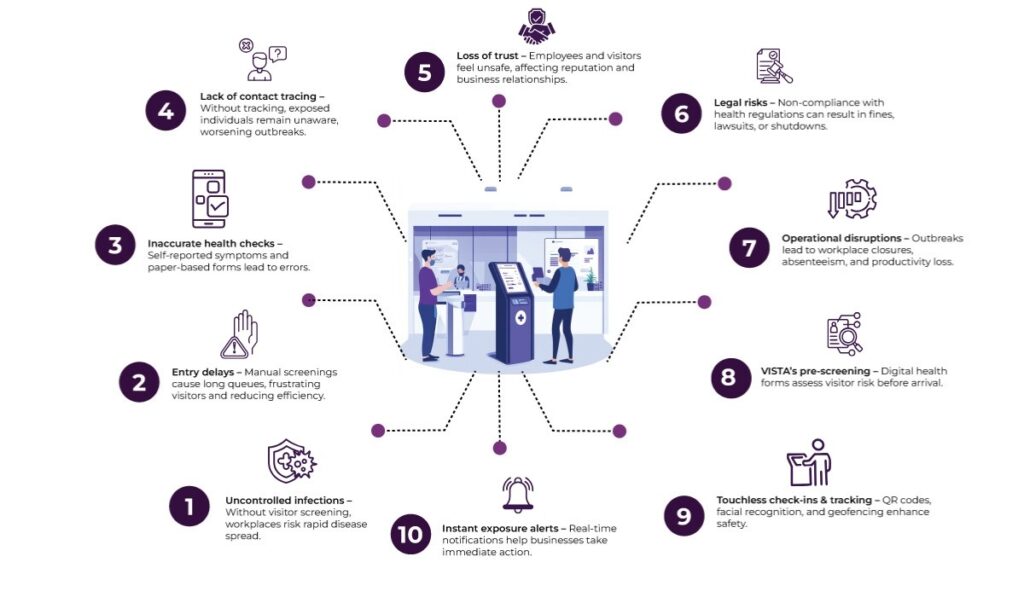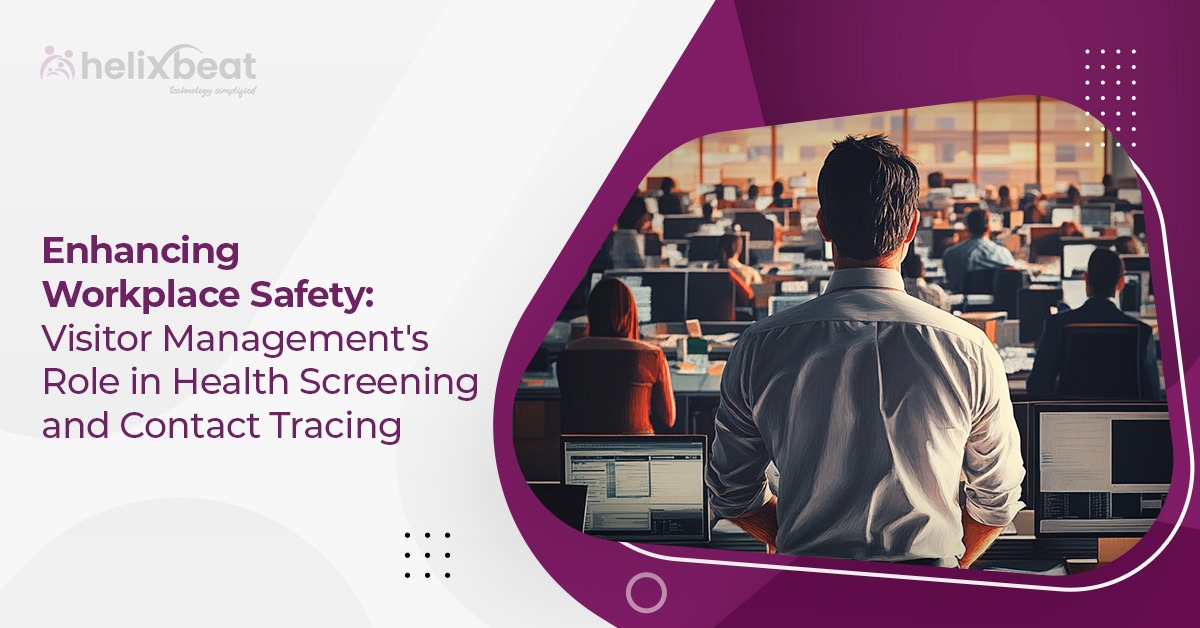Table of Contents
Introduction
In early 2020, a corporate office in Singapore welcomed an international client. Routine visitor logs were in place, but no health screenings were conducted. Days later, that visitor tested positive for COVID-19. With no way to track interactions, the virus spread unchecked among employees. Within a week, the company had to shut down, suffering major financial and reputational losses.
This incident highlights the crucial role of visitor management platforms in health screening and contact tracing. Without these measures, workplaces risk exposing employees to infections, facing legal liabilities, and experiencing operational disruptions. A robust visitor management platform—like VISTA—can prevent such crises through pre-screening, automated health checks, real-time contact tracing, and instant exposure alerts. By integrating these features, businesses create a safer, more efficient environment while ensuring compliance with health regulations.
Let’s find how VISTA’s advanced visitor management platform can transform workplace safety and prevent future outbreaks.
What If Health Screening and Contact Tracing Were Not Implemented in Premises?
Ignoring health screening and contact tracing in a workplace or public facility can have severe consequences. Without these measures, businesses expose employees, visitors, and the community to uncontrolled disease outbreaks, legal issues, and operational disruptions. Here’s a closer look at the potential risks:
1. Uncontrolled Spread of Infections
Without health screenings, visitors and employees can enter the premises without undergoing symptom checks, significantly increasing the risk of spreading contagious diseases such as COVID-19, influenza, or other viral infections. In many cases, asymptomatic carriers may unknowingly transmit infections, making it challenging to control outbreaks before they escalate.
This risk is even greater in high-traffic areas like offices, malls, and event spaces, where large numbers of people interact daily, turning these locations into potential hotspots for disease transmission. Without a proper screening process, businesses and public spaces remain vulnerable to widespread health threats, putting the safety of employees, customers, and visitors at risk.
2. Long Queues & Delays at Entry Points
Manual health screening processes, such as temperature checks and symptom questionnaires, often result in long waiting times at entrances, creating bottlenecks that disrupt the flow of visitors. The delays can lead to frustration among visitors, making them feel uncomfortable or rushed when answering health-related questions.
As a result, some individuals may provide inaccurate responses just to speed up the process, undermining the effectiveness of the screening. Additionally, employees responsible for conducting manual screenings may struggle to keep up with the high volume of visitors, leading to operational inefficiencies and diverting resources from other essential tasks. This not only affects workplace productivity but also increases the likelihood of errors in health assessments, reducing the overall effectiveness of the screening process.
3. Inaccurate Health Screening Results
Visitors might feel uncomfortable disclosing symptoms due to privacy concerns or the fear of being denied entry, leading them to withhold crucial health information. Additionally, relying solely on temperature checks is not always reliable, as many infections, including COVID-19, can be spread by asymptomatic carriers who show no visible signs of illness. This creates a false sense of security, allowing potential health risks to go undetected.
Furthermore, paper-based health screening forms are prone to human errors, misinterpretations, or even dishonest reporting, making the entire screening process ineffective. Without a secure and accurate system in place, organizations risk failing to identify potential health threats, putting both employees and visitors at risk.
4. No Way to Track & Alert Exposed Individuals
Without a contact tracing system, identifying individuals who have had close contact with an infected visitor or employee becomes nearly impossible, increasing the risk of uncontrolled disease transmission. Businesses and health authorities lack real-time data to track potential exposure, leading to delayed responses in isolating affected individuals. This delay allows infections to spread further before appropriate measures are taken.
In the absence of precise contact tracing, organizations may be forced to implement mass quarantines as a precautionary measure, disrupting operations and causing significant inconvenience to employees and visitors alike. Without an efficient system in place, businesses struggle to maintain a safe environment, ultimately affecting productivity and public trust.
5. Workplace Panic & Loss of Trust
- Employees and visitors may feel unsafe and hesitant to enter premises if they believe that no preventive measures are in place.
- Businesses risk reputation damage if an outbreak occurs, leading to negative media attention and loss of customer trust.
- Key stakeholders, including clients and partners, may avoid in-person meetings, affecting business relationships.
6. Legal & Compliance Issues
- Many industries require strict health and safety regulations, including mandatory screening and tracing.
- Failure to comply can result in hefty fines, legal action, or even forced business closure.
- Employees and visitors who contract illnesses due to lack of preventive measures may file lawsuits, adding to financial losses.
7. Operational Disruptions & Productivity Loss
- If an outbreak occurs within the workplace, business operations may be forced to shut down temporarily.
- Absenteeism increases, affecting project deadlines and overall productivity.
- Without automated visitor tracking, businesses struggle to determine which areas need sanitization and deep cleaning, delaying work resumption.
How does the visitor management platform help with health screening?
1. VISTA’s Pre-Registration with Health Questionnaire
VISTA visitor management platform enables visitors to complete a health declaration form before arrival, reducing wait times at entry points and enhancing workplace safety.
- Visitors provide essential health details, including recent symptoms, travel history, and vaccination status, allowing businesses to assess risk levels before granting entry.
- This pre-screening process ensures that only visitors meeting the health requirements are allowed access, preventing potential exposure to contagious illnesses.
- By digitizing the process, the VISTA visitor management platform eliminates the need for paper-based forms, reducing manual errors and enhancing data accuracy.
2. VISTA’s Touchless Check-In with Temperature Screening
VISTA visitor management platform provides a contact-free check-in process, ensuring minimal physical interaction while maintaining strict health protocols.
- Visitors scan a QR code or use facial recognition at the entrance, eliminating the need for shared check-in devices, reducing the risk of contamination.
- Integrated thermal scanners automatically detect visitors with fever or abnormal temperatures, preventing entry for individuals showing early signs of infection.
- This feature improves efficiency, reducing long queues and ensuring smooth and safe visitor flow.
3. VISTA’s Vaccination & Test Record Verification
To strengthen workplace safety, VISTA visitor management platform enables automated verification of health records, ensuring compliance with organizational health policies.
- Visitors can upload and verify their vaccination certificates or negative test results, allowing businesses to enforce health-based access control.
- The system automatically denies access to individuals who do not meet health requirements, ensuring only healthy individuals enter the premises.
- This feature reduces administrative burdens on security staff by automating document verification, ensuring compliance without manual intervention.
4. VISTA’s Automated Approval & Access Control
VISTA’s visitor management platform intelligent health screening system determines entry eligibility based on pre-defined safety protocols.
- The system automatically approves or denies entry based on health screening results, reducing the risk of human error.
- Integration with access control systems ensures that only pre-approved visitors and employees can enter, preventing unauthorized individuals from gaining access.
- Businesses can customize rules, such as requiring a negative test result within a specific timeframe, ensuring strict adherence to safety guidelines.
5. VISTA’s PPE Compliance & Reminders
To promote a culture of safety and hygiene, VISTA visitor management platform enforces compliance with personal protective equipment (PPE) regulations.
- The system monitors whether visitors are wearing masks and following hygiene protocols upon entry.
- Automated reminders and alerts prompt individuals to sanitize hands, wear masks, and maintain social distancing.
- By encouraging PPE compliance, VISTA visitor management platform reduces the risk of airborne transmission, creating a safer environment for employees and guests.
Essential Contact Tracing Features in VISTA for a Safer Workplace
VISTA’s visitor management platform integrates advanced contact tracing features to enhance workplace safety and streamline visitor tracking. Here’s how VISTA visitor management platform ensures effective contact tracing:
1. Digital Visitor Logs & Check-In Tracking
VISTA visitor management platform maintains a real-time digital record of visitor movements, ensuring accurate tracking.
- Logs store visitor details, check-in/check-out timestamps, and location history, making it easy to trace interactions.
- This eliminates paper-based logs, reducing errors and improving data security.
2. Real-Time Contact Mapping & Alerts
VISTA visitor management platform enables instant contact tracing by identifying visitor interactions inside the premises.
- The system tracks who a visitor interacted with and provides a detailed contact map.
- If a visitor tests positive, automated alerts notify exposed individuals, ensuring prompt action.
3. Geofencing & Movement Monitoring
VISTA uses geofencing and Bluetooth/RFID tracking to monitor visitor locations.
- Businesses can restrict access to high-risk areas based on health status.
- Movement tracking helps identify potential exposure zones within the facility.
4. Instant Notification System for Exposure Alerts
VISTA ensures rapid communication in case of potential exposure.
- Hosts, employees, and management receive real-time notifications if a visitor is flagged as a positive case.
- Exposure alerts prevent further spread and allow for immediate containment measures.
5. Data Privacy & Automatic Record Removal
VISTA prioritizes visitor privacy while maintaining compliance with global data regulations.
- Ensures compliance with GDPR, HIPAA, and local data laws to protect visitor information.
- Visitor records are automatically removed after a set period, balancing safety and privacy.
Final thoughts
Keeping workplaces safe isn’t just about rules—it’s about protecting people. VISTA makes this easier by screening visitors before they arrive, enabling touchless check-ins, and tracking interactions in real-time. If a health risk arises, instant alerts help businesses act fast, preventing further spread.
Features like geofencing, digital visitor logs, and PPE reminders ensure that safety measures don’t feel like a hassle but a seamless part of the experience. Plus, privacy is a priority, with automatic record removal and compliance with global regulations. With VISTA visitor management platform, businesses can create a secure, welcoming environment where everyone feels protected.

Frequently asked question
1. Why is a visitor management system important for health screening?
A visitor management system automates health screening, ensuring only safe individuals enter the premises. It reduces manual errors, speeds up check-ins, and enhances workplace safety.
2. How does contact tracing work in a visitor management system?
The system tracks visitor check-ins, interactions, and movement within the facility. If an exposure risk is detected, it instantly alerts affected individuals to take necessary precautions.
3. Can a visitor management system help reduce long entry queues?
Yes, digital pre-registration and touchless check-ins streamline entry, reducing wait times and preventing bottlenecks at access points.
4. How does a visitor management system ensure data privacy?
It complies with GDPR, HIPAA, and other data protection laws by securely storing visitor records and automatically deleting them after a set period.
5. What features help monitor visitor health status?
Key features include pre-registration health questionnaires, temperature screening, vaccination record verification, and automated approval for safe entry.
6. Can the system integrate with existing security and access control systems?
Yes, modern visitor management platforms integrate with access control systems, allowing only pre-approved visitors and employees to enter.
7. How does the system notify people of potential exposure?
If a visitor tests positive, the system generates real-time alerts to notify exposed individuals, hosts, and management for prompt action.
8. Is a visitor management system only useful during pandemics?
No, it enhances workplace security, prevents unauthorized access, and ensures overall safety by tracking visitor movements and interactions.














